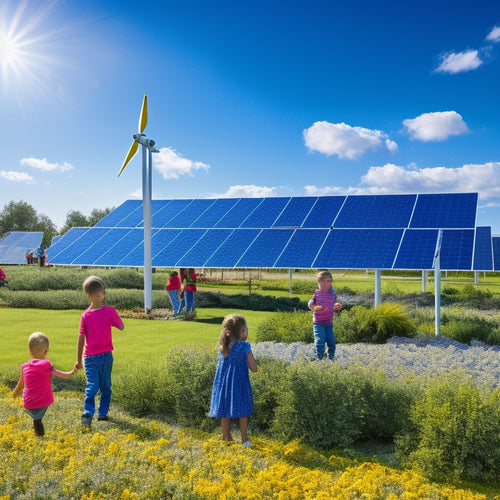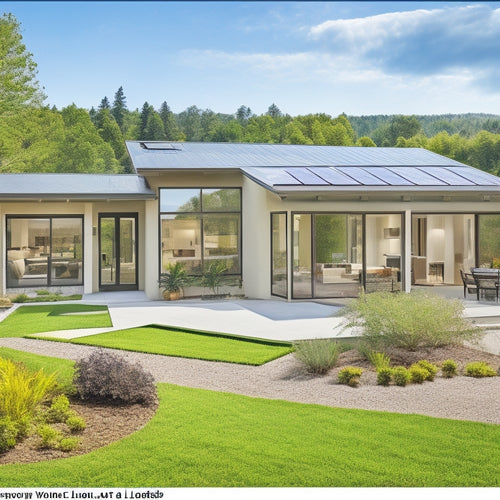
Save Money With These Solar Panel Efficiency Tips
Share
By implementing a few simple yet effective solar panel efficiency tips, you can enhance your system's energy output by up to 46%. Start by adjusting your panel's angle seasonally to capture ideal sunlight, and strategically place them to minimize shading. Regular cleaning can also increase energy output, while real-time performance monitoring helps identify inefficiencies. Upgrading to high-efficiency panels can further improve energy production, and integrating energy-storage systems can reduce your reliance on the grid. By putting these tips into practice, you'll be well on your way to maximizing your solar panel system's potential - and there's even more ways to enhance your system's performance waiting to be found.
Key Takeaways
- Optimize solar panel angle seasonally to capture optimal sunlight, increasing energy output by up to 46%.
- Trim or remove trees and install panels on south-facing roofs with a 15° to 40° orientation for optimal energy output.
- Regularly clean panels to boost energy output, as dust and debris can reduce production by up to 25%.
- Conduct regular maintenance checks to ensure peak efficiency, inspecting panels, connections, and wiring.
- Integrate energy-storage systems to store excess energy, reducing reliance on the grid and enhancing energy independence.
Optimize Your Solar Panel Angle
Adjust Your Solar Panel Angle
Illumination is the key to releasing the full potential of your solar panels, and adjusting their angle is crucial to maximizing energy from the sun. You'll want to verify your solar panel orientation is modified to capture the best amount of sunlight throughout the year. This requires seasonal adjustments to account for the sun's changing position in the sky.
During the summer months, the sun is higher in the sky, so you'll want to tilt your panels at a steeper angle to enhance energy production. Conversely, during the winter months, the sun is lower in the sky, and a shallower angle is more effective.
By making these adjustments, you can increase energy output by up to 46%. It's important to note that the ideal angle will vary depending on your location and the time of year. Consult with a professional or make use of online resources to determine the best angle for your specific situation.
Clean Panels for Maximum Output
You can considerably increase your solar panel's energy output by ensuring they're free from dirt and debris.
To achieve this, you'll need to remove dust and other obstructions, establish a regular cleaning schedule, and use ideal cleaning methods that won't damage your panels.
Dust and Debris Removal
Across the globe, solar panels are installed in various environments, from dusty deserts to coastal areas with high salt content, exposing them to diverse types of dust and debris.
As a solar panel owner, you know that these impurities can greatly reduce your system's energy output. To maximize your solar panel's performance, it's crucial to remove dust and debris regularly.
You can start by performing seasonal maintenance to clean your panels. Use eco-friendly cleaning products and soft-bristled brushes to avoid damaging the panels' surface.
Avoid using high-pressure washes, abrasive materials, or harsh chemicals, as they can scratch or discolor the panels. Instead, opt for a gentle cleaning process that effectively removes dirt and grime.
Regular Cleaning Schedule
Establishing a regular cleaning schedule is vital to maintaining your solar panels' ideal performance. You should clean your solar panels regularly to guarantee maximum energy output, as dirty panels can reduce energy production by up to 25%.
The cleaning frequency depends on various factors, including your location, climate, and surrounding environment. If you live in a dusty or polluted area, you may need to clean your panels more frequently.
Weather considerations also play an important role in determining your cleaning schedule. For instance, if you live in an area with high rainfall, you may not need to clean your panels as frequently, as the rain will help to wash away dirt and debris.
On the other hand, if you live in a dry and dusty region, you may need to clean your panels every 2-3 months. Additionally, seasonal changes can also impact your cleaning schedule. For example, during the summer months, you may need to clean your panels more frequently due to increased dust and debris accumulation.
Optimal Cleaning Methods
Optimal Cleaning Techniques (Clean Panels for Maximum Output)
The efficiency of your solar panels relies heavily on the cleaning method used, as improper techniques can potentially damage the panels or leave behind streaks and residue that reduce energy output. You must use a gentle yet effective approach to maintain your solar panel's performance.
Avoid using harsh chemicals, abrasive materials, or high-pressure washes, as they can damage the solar panel materials. Instead, use a soft-bristled brush or a microfiber cloth to remove loose debris.
For more thorough cleaning, mix a solution of mild soap and water, and apply it to the panels using a soft-bristled brush or sponge. Rinse the panels thoroughly with clean water to prevent soap residue from accumulating.
The cleaning frequency will depend on your location and the amount of debris accumulated. In dusty or polluted areas, you may need to clean your solar panels every 2-3 months. In cleaner environments, a cleaning frequency of every 6-12 months may be sufficient.
Monitor Performance in Real-Time
You can track your solar panel's live data to monitor its performance in real-time, allowing you to identify areas of improvement and optimize energy output.
By analyzing energy output data, you'll be able to pinpoint any inefficiencies and make adjustments to maximize your solar panel's potential.
This real-time monitoring enables you to respond quickly to any issues, ensuring your solar panel operates at peak efficiency.
Live Data Tracking
How closely are you monitoring your solar panel's performance? With live data tracking, you can stay on top of your system's efficiency in real-time. This feature provides instant observations into your energy production, allowing you to identify areas for improvement and enhance your system's performance.
| Performance Metric | What it Reveals |
|---|---|
| Energy Output (kWh) | Total energy generated by your solar panel system |
| Power Output (W) | Instantaneous power output of your system |
| Efficiency (%) | System efficiency compared to its best performance |
| Temperature (°C) | Panel temperature, which affects energy output |
| Voltage (V) | Voltage output, which impacts system performance |
Energy Output Analysis
By monitoring your solar panel's energy output in real-time, you can pinpoint periods of peak performance and identify opportunities to enhance energy production. This allows you to make data-driven decisions to maximize your energy production and reduce energy waste.
With real-time monitoring, you can track your energy output against weather patterns, panel technology, and other factors to refine your energy production strategy.
Some key benefits of real-time energy output analysis include:
-
Identifying underperforming panels: Quickly detect panels that aren't producing energy at ideal levels, and take corrective action to restore peak performance.
-
Enhancing energy production: Analyze your energy output data to identify opportunities to adjust your panel angle, cleaning schedule, or other factors to maximize energy production.
-
Predictive maintenance: Use real-time data to anticipate and prevent equipment failures, reducing downtime and ensuring continuous energy production.
Upgrade to High-Efficiency Panels
The latest advancements in solar panel technology have led to the development of high-efficiency panels that can markedly enhance your solar energy harvest.
These state-of-the-art panels boast higher power output ratings, often exceeding 400 watts, and efficiencies of up to 22%. By upgrading to high-efficiency panels, you can generate more power per unit area, reducing the overall number of panels required for your installation.
This, in turn, can lead to lower installation costs and a faster return on investment. For instance, high-efficiency panels can reduce the required roof space by up to 30%, resulting in significant savings on installation and maintenance costs.
Furthermore, these advanced panels often come with improved durability and longer warranties, ensuring peak performance over an extended period.
Reduce Shading With Strategic Placement
You've invested in high-efficiency panels, but their performance can be severely hindered if they're not placed strategically to minimize shading.
Even partial shading can greatly reduce energy output, so it's essential to enhance panel placement.
To reduce shading, consider the following:
-
Assess tree positioning: Identify trees that cast shade on your roof, especially during peak sun hours. Trim or remove trees if possible, or consider installing panels in a location that avoids tree shade.
-
Optimize roof orientation: Confirm your panels are installed on a roof section with an ideal orientation (between 15° and 40°) to maximize energy output. A south-facing roof is ideal, but panels can still be effective on east- or west-facing roofs.
-
Avoid obstacles: Keep panels clear of obstacles like vents, skylights, and chimneys, which can cast shade and reduce energy output.
Pair With Energy-Storage Systems
Maximizing your solar panel efficiency also involves pairing them with energy-storage systems, which can greatly impact your overall energy independence and savings.
By integrating batteries with your solar panels, you can store excess energy generated during the day for use during the night or on cloudy days, reducing your reliance on the grid and increasing your energy independence. This not only leads to cost savings but also provides backup power during outages, ensuring your home or business remains operational.
Additionally, energy-storage systems enable you to optimize your energy management, allowing you to use renewable resources more efficiently and reducing your environmental impact.
With battery integration, you can also participate in grid stability programs, helping to stabilize the grid and earning revenue in the process.
For those who desire off-grid living, energy-storage systems are essential for achieving true sustainability benefits.
Schedule Regular Maintenance Checks
Regular maintenance checks are essential to ensuring your solar panels operate at peak efficiency, and it's important to schedule them consistently.
By doing so, you'll be able to identify and address any potential issues before they become major problems, saving you time and money in the long run. Preventive maintenance is key to maximizing your solar panel's performance and extending its lifespan.
Some important tasks to include in your regular maintenance checks are:
- Inspecting the panels for dirt, debris, and damage, and cleaning them as needed
- Verifying that all connections and wiring are secure and not damaged
- Monitoring your system's performance and identifying any drops in energy production
Frequently Asked Questions
Can I Install Solar Panels on My Own to Save Money?
You can attempt a DIY installation to reduce upfront costs, but it's essential to contemplate the potential risks and limitations; without proper proficiency, you might compromise the system's performance, negating any cost savings.
Do Solar Panels Work During Power Outages?
Did you know that 70% of US households experience power outages annually? During outages, you'll find that solar panels don't provide power unless you have a battery backup or grid-tie inverter, ensuring continuous solar panel functionality as part of your power outage solutions.
Are Solar Panels Affected by Weather Conditions?
You'll notice that solar panel performance is markedly impacted by weather conditions, with factors like cloud cover, temperature, and humidity affecting energy output, so it's essential to take these variables into account when optimizing your system for maximum efficiency.
Can I Sell Excess Energy Back to the Grid?
As you capture the sun's energy, imagine excess power flowing back into the grid, earning you credits. With net metering benefits, you can sell excess energy back to the grid, accumulating energy credit options, and offsetting your future consumption.
How Long Does It Take to Break Even on Solar Panels?
You'll break even on solar panels in 5-7 years, considering the average solar panel lifespan of 25-30 years and installation costs ranging from $15,000 to $30,000, depending on system size and quality, allowing you to reap long-term energy savings.
Conclusion
As you capture the sun's energy, imagine your electricity bills melting away like ice in the scorching summer heat. By implementing these solar panel efficiency tips, you'll be maximizing your energy harvest and reaping the financial rewards. With optimized angles, sparkling clean panels, and real-time monitoring, you'll be generating power like a pro. Upgrade to high-efficiency panels, strategically place them to reduce shading, and pair with energy-storage systems for a seamless energy flow. Stay on top of maintenance, and watch your savings soar like a bird taking flight!
Related Posts
-

Solar Power for Community Energy Independence
Solar power is essential for your community's energy independence, offering both environmental and economic benefits....
-

Energy-Efficient Home Upgrades for Cost Reduction
To reduce costs with energy-efficient home upgrades, focus on essential improvements like smart thermostats, energy-e...
-

Passive Solar Design Strategies for Homes
To effectively implement passive solar design strategies in your home, focus on ideal building orientation and strate...


